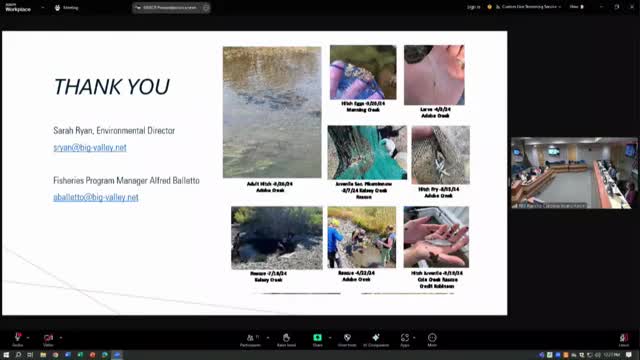Central Valley Water Board tackles harmful algal blooms and supports Big Valley tribes
December 23, 2024 | State Water Resources Control Board, Boards and Commissions, Executive, California
This article was created by AI summarizing key points discussed. AI makes mistakes, so for full details and context, please refer to the video of the full meeting. Please report any errors so we can fix them. Report an error »

The State Water Resources Control Board meeting on December 18, 2024, highlighted critical updates regarding water quality and its impact on local ecosystems, particularly focusing on the hitch fish species. Erin Bender, a senior scientist with the Division of Water Rights, presented findings that underscore the complex challenges facing hitch survival, notably the significant role of water quality issues in the lake.
Bender reported that the Central Valley Regional Water Board is actively addressing these concerns through various initiatives. One key effort is the nutrient Total Maximum Daily Load (TMDL) management program aimed at controlling nonpoint discharges into the lake. Additionally, the board is collaborating with Big Valley tribes on harmful algal bloom (HAB) sampling and working with the Blue Ribbon Committee on a comprehensive study of these blooms.
The data emerging from these studies reveals that harmful algal blooms are driven not only by external factors but also by internal conditions, such as low dissolved oxygen levels and water column mixing caused by wind and wave action. The next steps involve genetic typing of the cyanobacteria responsible for these blooms and pilot studies to explore potential management strategies.
In response to the challenges posed by low streamflow, the board is also evaluating options for streamflow augmentation. This would allow property owners to release water into dry streams, helping to stabilize conditions for hitch and other aquatic life until rescue operations can be conducted.
The meeting also touched on ongoing coordination with the Department of Toxic Substances Control (DTSC) and the Environmental Protection Agency (EPA) regarding the Sulfur Bank Mercury Mine, indicating a comprehensive approach to managing water quality and protecting local ecosystems.
These discussions underscore the urgency of addressing water quality issues in California, particularly as they relate to the survival of vulnerable species like the hitch. The board's proactive measures signal a commitment to improving water conditions and ensuring the health of the region's aquatic environments.
Bender reported that the Central Valley Regional Water Board is actively addressing these concerns through various initiatives. One key effort is the nutrient Total Maximum Daily Load (TMDL) management program aimed at controlling nonpoint discharges into the lake. Additionally, the board is collaborating with Big Valley tribes on harmful algal bloom (HAB) sampling and working with the Blue Ribbon Committee on a comprehensive study of these blooms.
The data emerging from these studies reveals that harmful algal blooms are driven not only by external factors but also by internal conditions, such as low dissolved oxygen levels and water column mixing caused by wind and wave action. The next steps involve genetic typing of the cyanobacteria responsible for these blooms and pilot studies to explore potential management strategies.
In response to the challenges posed by low streamflow, the board is also evaluating options for streamflow augmentation. This would allow property owners to release water into dry streams, helping to stabilize conditions for hitch and other aquatic life until rescue operations can be conducted.
The meeting also touched on ongoing coordination with the Department of Toxic Substances Control (DTSC) and the Environmental Protection Agency (EPA) regarding the Sulfur Bank Mercury Mine, indicating a comprehensive approach to managing water quality and protecting local ecosystems.
These discussions underscore the urgency of addressing water quality issues in California, particularly as they relate to the survival of vulnerable species like the hitch. The board's proactive measures signal a commitment to improving water conditions and ensuring the health of the region's aquatic environments.
View full meeting
This article is based on a recent meeting—watch the full video and explore the complete transcript for deeper insights into the discussion.
View full meeting
